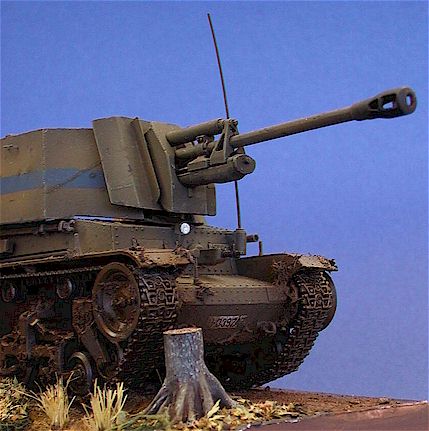Skoda R2 TACAM Tank Destroyer
model by Micke Arreborn
text and photos by by Martin Waligorski
It looks like one more variation on the Marder concept,  but it isn’t. Well, at least strictly speaking. Like the Marder, Romanian R2 TACAM anti-aircraft gun was the result of an improvisation. However, unlike the Marder, it was intended to replace the Romanian tank force rather than support it.
but it isn’t. Well, at least strictly speaking. Like the Marder, Romanian R2 TACAM anti-aircraft gun was the result of an improvisation. However, unlike the Marder, it was intended to replace the Romanian tank force rather than support it.
Romanian armies fighting alongside German, and later Soviet forces were generally very poorly equipped. During the first year of operation Barbarossa, the backbone of the Romanian armoured divisions was the Czech R-2 tank. R-2 was nothing else than the export version of Skoda LT vz. 35, also known under its German designation Panzerkampfwagen 35(t).
This type of tank, still used by the Germans in quantity during the French campaign, was of very limited value in Russia due to its light construction and problems with operating it in cold weather. In fact, the Germans turned many of their still operational Pz 35(t) to Romanians to match the R-2s already in use. Disaster struck at Stalingrad, where during the massive Soviet counterattack, the Romanian divisions lost almost sum total of their armour.
During the subsequent reconstruction of the Romanian armoured divisions, there was no space for general improvements in quality beyond modifications to the R-2 design. As the conclusions for supplementing the armour and changing the main gun were not favourable, a concept was born of rebuilding the remaining R-2 tanks to tank destroyers. These could be produced in Romania using captured Soviet 76.2mm ZIS-3 M1942 guns as the main armament and armour plates of the captured T-26 and T-60 tanks.
It was assessed that such hybrids would be more valuable in the battlefield that the tanks they were intended to replace, and the project was given a green light.
In mid 1943, a team directed by Lt.Col. Constantin Ghiulai completed the design. The new vehicle received a designation T.A.C.A.M. Skoda R-2 (the acronym TACAM meaning Tun Anticar cu Afet Mobil, translating to mobile antitank gun). A prototype was developed from July to September of 1943.
As none of the Axis powers did have their own 76.2 mm ammunition, the Romanians developed and produced their own armour-piercing rounds for the gun. It proved effective against the frontal armour of the T-34/76 at distances up to 600 metres.
In February, 1944 a series of 40 vehicles was ordered, but only 20 vehicles were eventually converted until June 1944. The resulting vehicle proved combat-worthy, although hampered by the notoriously high profile, and, more importantly, limited traverse of the gun and poor optics.
In July 1944, the TACAM R-2s were distributed to the 1st Tank Regiment were they formed the 63th Tank-Destroyer Company. With sudden turn of political events, they were used against Germans in the liberation of Romanian territory. In 1945, only six TACAMs remained operational and these were transferred to the 2nd Tank Regiment operationg in Austria and Moravia. By the end of the war there was only one surviving vehicle.
The Kit
Micke Arreborn is the author of this model, built from CMK kit.
Like the full-size vehicle, the kit is a conversion of a standard Pz 35(t) kit. It contains almost all of the original parts for the Pz 35(t) kit, plus a new superstructure and gun, and a small photoetched fret.
The kit offered a hollow interior which had to be furnished out. However, Micke found that many items of the original turret interior of the Pz 35(t) – which was included in the package – fit the bill just right in this area.
The model was painted with the basic colour of Tamiya Olive Drab, followed by ageing and weathering as shown. The markings are of 1st Tank Regiment, 63th Tank-Destroyer Company in 1944.
This article was originally published in IPMS Stockholm Magazine in June 2003.






